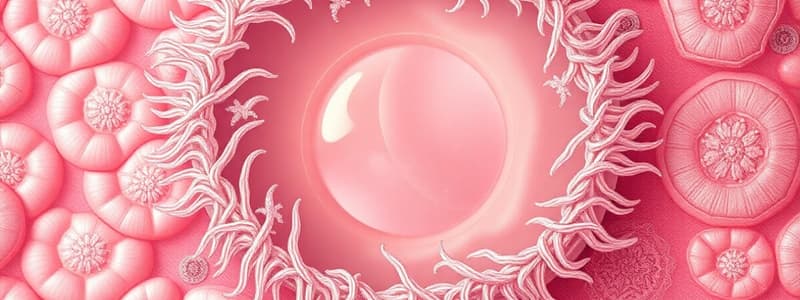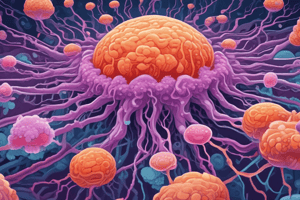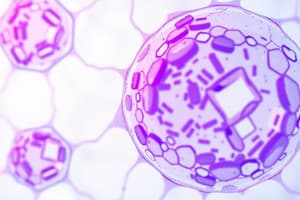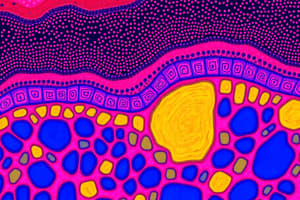Podcast
Questions and Answers
What role do fibroblasts play in connective tissue?
What role do fibroblasts play in connective tissue?
- They primarily store energy in the form of lipids.
- They reduce inflammation in tissue.
- They produce and maintain the extracellular matrix. (correct)
- They facilitate cellular communication.
Which of the following types of connective tissue is derived from mesenchyme?
Which of the following types of connective tissue is derived from mesenchyme?
- Embryonic connective tissue (correct)
- Adipose tissue
- Mature cartilage
- Dense regular connective tissue
Which type of adipocyte is specialized for heat production?
Which type of adipocyte is specialized for heat production?
- Mature adipocytes
- Transitional adipocytes
- Brown adipocytes (correct)
- White adipocytes
What are transient cells in connective tissue primarily involved in?
What are transient cells in connective tissue primarily involved in?
How are connective tissues classified?
How are connective tissues classified?
Which of the following cells are considered permanent residents of connective tissue?
Which of the following cells are considered permanent residents of connective tissue?
What is the primary function of dense regular connective tissue?
What is the primary function of dense regular connective tissue?
Which cell type primarily comprises adult adipose tissue?
Which cell type primarily comprises adult adipose tissue?
What transformation do fibroblasts undergo after synthesizing the matrix?
What transformation do fibroblasts undergo after synthesizing the matrix?
Which type of connective tissue is characterized by its undifferentiated mesenchymal cells and gel-like ground substance?
Which type of connective tissue is characterized by its undifferentiated mesenchymal cells and gel-like ground substance?
What is a characteristic feature of unilocular adipocytes?
What is a characteristic feature of unilocular adipocytes?
Which type of transient cell is primarily responsible for initiating allergic responses?
Which type of transient cell is primarily responsible for initiating allergic responses?
What type of connective tissue is most widely distributed in the body?
What type of connective tissue is most widely distributed in the body?
What are multilocular adipocytes primarily characterized by?
What are multilocular adipocytes primarily characterized by?
Which of the following cells is derived from B lymphocytes and enters connective tissue?
Which of the following cells is derived from B lymphocytes and enters connective tissue?
Which category of connective tissue includes cartilage and bone?
Which category of connective tissue includes cartilage and bone?
What is the main role of fibroblasts in connective tissue?
What is the main role of fibroblasts in connective tissue?
Which type of connective tissue is primarily found in the umbilical cord?
Which type of connective tissue is primarily found in the umbilical cord?
What distinguishes white adipocytes from brown adipocytes?
What distinguishes white adipocytes from brown adipocytes?
Which type of cell is considered a transient cell in connective tissue?
Which type of cell is considered a transient cell in connective tissue?
What characteristic is specific to elastic fibers in connective tissue?
What characteristic is specific to elastic fibers in connective tissue?
Which of the following components is NOT part of the connective tissue ground substance?
Which of the following components is NOT part of the connective tissue ground substance?
Which type of connective tissue fiber is primarily responsible for providing tensile strength?
Which type of connective tissue fiber is primarily responsible for providing tensile strength?
Flashcards
Fibrocytes
Fibrocytes
Mature connective tissue cells that secrete the matrix.
Adipocytes (fat cells)
Adipocytes (fat cells)
Cells filled with lipid droplets, either unilocular or multilocular, derived from mesenchymal cells.
Unilocular Adipocytes
Unilocular Adipocytes
Adipocytes with a single, large lipid droplet pushing the nucleus to the periphery.
Multilocular Adipocytes
Multilocular Adipocytes
Signup and view all the flashcards
Transient cells
Transient cells
Signup and view all the flashcards
Loose Areolar Connective Tissue
Loose Areolar Connective Tissue
Signup and view all the flashcards
Mesenchymal Connective Tissue
Mesenchymal Connective Tissue
Signup and view all the flashcards
Mucoid Connective Tissue
Mucoid Connective Tissue
Signup and view all the flashcards
Occluding Junction
Occluding Junction
Signup and view all the flashcards
Anchoring Junctions
Anchoring Junctions
Signup and view all the flashcards
Zonula Adherens
Zonula Adherens
Signup and view all the flashcards
Macula Adherens (Desmosomes)
Macula Adherens (Desmosomes)
Signup and view all the flashcards
Hemidesmosomes
Hemidesmosomes
Signup and view all the flashcards
Communicating Junction (Gap Junction)
Communicating Junction (Gap Junction)
Signup and view all the flashcards
Connective Tissue
Connective Tissue
Signup and view all the flashcards
Extracellular Matrix
Extracellular Matrix
Signup and view all the flashcards
Ground Substance
Ground Substance
Signup and view all the flashcards
Proteoglycan Aggregate
Proteoglycan Aggregate
Signup and view all the flashcards
What is the function of collagen fibers in connective tissue?
What is the function of collagen fibers in connective tissue?
Signup and view all the flashcards
How do elastic fibers contribute to connective tissue?
How do elastic fibers contribute to connective tissue?
Signup and view all the flashcards
What is the role of reticular fibers?
What is the role of reticular fibers?
Signup and view all the flashcards
Where are collagen fibers synthesized?
Where are collagen fibers synthesized?
Signup and view all the flashcards
Fibroblast
Fibroblast
Signup and view all the flashcards
Hyaluronidase
Hyaluronidase
Signup and view all the flashcards
Study Notes
Epithelial Polarity
- Epithelial cells have apical, basal, and lateral surfaces
- These surfaces have specialized structural modifications for specific functions
- Apical specializations include microvilli and stereocilia
- Microvilli are non-motile projections increasing surface area for fluid absorption
- Stereocilia are long, branching microvilli, common in the male genital ducts
- Cilia and flagella are motile projections
- Cilia are hair-like and longer than microvilli
- Flagella are similar to cilia but much longer, and typically one per cell
- Cilia and flagella have a basal body, a shaft, and rootlets, made of microtubules
Basal Specializations
- Basal infoldings increase the surface area for ion transport (e.g., in kidney tubules)
- Basement membrane is a structural modification in the basal domain
- Cell-to-matrix junctions include hemidesmosomes connecting cells to the basement membrane
Cell Adhesion Molecules (CAMs)
- Transmembrane glycoproteins with extracellular domains that bind other CAMs or matrix proteins
- Cytoplasmic domains attach to cytoskeleton
- Cell adhesion is a dynamic process, essential for migration and metastasis
Connecting Cell Junctions
- Occluding junctions (tight junctions): prevent passage of substances between cells
- Anchoring junctions: provide strong attachment and link cytoskeletons of adjacent cells
- Communicating junctions (gap junctions): allow the exchange of ions/molecules between cells
Connective Tissue
- Connective tissue is the most abundant and widely-distributed tissue in the body
- Composed of cells and extracellular matrix
- Extracellular matrix is a non-living material filling spaces between cells
- Extracellular matrix consists of interstitial fluid and proteins (like fibronectin, laminin), proteoglycans
- Proteoglycans form a gel-like substance trapping water and acting as a medium for nutrient diffusion
- Connective tissue fibers include collagen, elastic, and reticular fibers
Connective Tissue Fibers
- Collagen fibers: strong, high tensile strength, appear white in fresh state, run in bundles
- Elastic fibers: flexible, allow stretching and recoiling, appear yellow
- Reticular fibers: form a network, support cells, found in organs like bone marrow, spleen
Connective Tissue Cells
- Fixed cells (resident): fibroblasts, chondrocytes, osteocytes, adipocytes
- Transient cells (wandering): macrophages, mast cells, plasma cells, leukocytes
- Fibroblasts: synthesize ground substance and fibers, can become quiescent fibrocytes
- Adipocytes: store energy in triglycerides, unilocular (fat) or multilocular (brown fat)
- Mast cells: release granules containing histamine, other mediators in allergic reactions
Connective Tissue Types
- Embryonic connective tissue (mesenchymal and mucous)
- Connective tissue proper (loose and dense irregular/regular, elastic, reticular)
- Specialized connective tissue (cartilage, bone, blood)
Integumentary System
- Skin is a major organ, composing about 16% of body weight
- Skin has two layers: epidermis (ectodermal) and dermis (mesodermal)
- Epidermis is a stratified squamous epithelium; keratinocytes are predominant, also melanocytes, Langerhans cells, Merkel cells
- Keratinocytes are continually shed and replaced from the basal layer
Studying That Suits You
Use AI to generate personalized quizzes and flashcards to suit your learning preferences.



